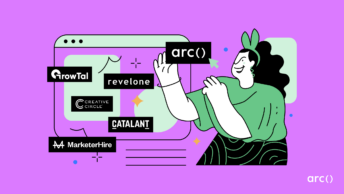The difference between companies that thrive in uncertainty and those that just get by boils down to one word: flexibility.
Flexible startups must adapt in tough times. They learn to turn challenges into opportunities, focusing on achieving their goals instead of just surviving.
This post aims to introduce you to an alternative hiring process. It’s not only for finding excellent remote software developers but also for uncovering skilled marketers and designers. This approach will enhance your organization’s flexibility, allowing you to hire with lower risks and still chase your major product development and marketing.
Looking for top talent fast? See how Arc can help you:
⚡️ Find developers, designers, marketers, and more
⚡️ Freelance or full-time remote + fully vetted
⚡️ Save up to 80% with global hires
Hire top talent with Arc risk-free →
What is contract-to-hire?
Contract-to-hire, also known as “temp-to-hire,” is essentially a short-term “trial” contract. It allows your company to test a hire before offering full-time employment. Think of it as “try before you buy,” for both sides of the employment relationship.
Under such a contract, you establish a paid trial period, typically lasting 1-3 months (though it can extend up to a year). During this time, the remote engineer works just like a regular employee. The key difference is the option to not offer full-time employment at the trial’s end. If the arrangement proves successful, you can then transition to standard, full-time employment.
Why startups should consider contract-to-hire
Startups, inherently dynamic and fast-paced, must make the right hires. It’s crucial to find people who not only possess the necessary skills but also fit the company culture and adapt quickly. Contract-to-hire serves as an excellent strategy for startups, offering a “try before you buy” approach that minimizes the risk of a poor hiring decision. This arrangement allows startups to assess a contractor’s abilities, work ethic, and cultural fit during the contract period.
Additionally, startups often operate with limited resources and tight budgets. Onboarding a full-time employee is a substantial cost, including benefits and potential severance packages. Contract-to-hire presents a cost-effective solution, mitigating these upfront expenses.
Contract-to-hire provides significant flexibility, a crucial aspect for startups whose needs may rapidly evolve. This approach enables startups to scale up or down in response to their current needs, thus maintaining the agility essential to succeed in the startup ecosystem.
How contract-to-hire differs from hiring a freelancer or agency
Contract-to-hire differs from hiring a freelancer, independent contractor, or agency. The most significant difference is that the developer you’ll employ will join your team like any other employee and follow the same company guidelines.
The primary advantage of contract-to-hire, especially for remote roles like software engineers, marketers, or designers, is the dedicated focus the professional will bring to your organization. They commit their full energy to your company’s goals without the distraction of other side projects. Plus, this arrangement offers the potential to transition them into long-term, full-time roles, securing their talent for your future needs.
From a financial standpoint, while you do take on the responsibility of paying taxes for these contract-to-hire employees (unlike freelancers who handle their own tax obligations), you save on the benefits typically offered to full-time staff. These benefits include paid vacation, sick leave, health insurance, retirement plans, and severance packages. This results in significant cost savings for your company.
It’s also key to understand that contract-to-hire employees are not the same as temporary workers. While temporary workers are often hired for specific projects or seasonal needs, contract-to-hire professionals are brought on to fully integrate into various roles within your organization. This period serves as a trial to assess their fit and potential as a full-time employee.
Read More: How to Do Taxes When Hiring a Freelance Developer
Adopt contract-to-hire for a leaner, more adaptable team
To stay ahead in today’s economy, many tech companies are turning to contract-to-hire as a flexible employment strategy for their software engineers and other tech workers.
Mike Knoop, co-founder of Zapier, announced via Twitter that their company is committed to continuing the hiring of remote engineers, including through contract-to-hire agreements.
At Google, the number of contract-to-hire and other contract workers now surpasses that of their full-time employees. Following the global pandemic, Apple has also increased its workforce by employing more contract-to-hire staff.
Matt Mullenweg, the founder of Automattic, whose brands include WordPress.com, Akismet, Gravatar, Crowdsignal, and Tumblr, is a strong advocate for the contract-to-hire approach. He believes:
“Before we hire anyone, they go through a trial process first, on contract. They can do the work at night or over the weekend, so they don’t have to leave their current job in the meantime. We pay a standard rate of $25 per hour, regardless of whether you’re applying to be an engineer or the chief financial officer.”
Why is there such interest in contract-to-hire? Below you can find the most significant benefits of this hiring method.
Safer than full-time employment
If you hire a full-time employee, it can be challenging to let them go if they don’t meet expectations. Severance costs, additional taxes, and paperwork are just some of the hurdles.
Moreover, when a full-time employee is let go, it can create workplace anxiety. Other employees might worry about their job security, leading to decreased productivity and morale.
Managers also face difficulty in having conversations about termination with full-time employees.
On the other hand, with temp-to-hire employees, these issues are significantly reduced. If a temp-to-hire employee isn’t the right fit, you can simply not renew their contract. This process is easier for managers and less worrying for full-time employees. There’s no severance to worry about and minimal paperwork involved.
This approach also offers the contractor, whether they’re a developer, marketer, or designer, a chance to demonstrate their capabilities. It moves beyond mere interview assessments to real-world performance evaluations.
Additionally, it allows you to observe how they blend with your organization’s culture before deciding on full-time employment. Avoiding a cultural mismatch is crucial, as it can negatively impact team morale and productivity.
Read More: Hiring In-House vs Remote Developers: Cost & Competitive Advantages
Offers greater flexibility
Uncertain times require the flexibility of keeping your options open. You can’t be sure how the situation will evolve and how your business needs will change.
As a result, you don’t want to make employment decisions that may be hard to reverse. With temp-to-hire employees, you get the added flexibility of postponing a full-time hiring decision, while getting to work on your projects today.
For the remote developer, greater flexibility is also important. The developer:
- Gets a chance to demonstrate their value to your organization
- Increases their qualifications
- Determines how happy they are with your company culture, and
- Expands their professional network
So even if they don’t end up working for you, it will be a big plus for them.
You can also try Arc, your shortcut to the world’s best remote talent:
⚡️ Access 450,000 top developers, designers, and marketers
⚡️ Vetted and ready to interview
⚡️ Freelance or full-time
Try Arc and hire top talent now →
More cost-effective
The median annual salary for a full-time developer is around $113,000. However, you have to pay an extra $37,500 more in mandatory employee benefits! That’s a whopping 32.3% above their base-level salary.
In uncertain economic times (and thus with staffing needs changing quickly), cost savings are even more imperative. With contract-to-hire, you can hire remote developers for the upcoming period without having to pay the extra 32.3% in benefits. You can add to the cost savings any severance pay that the law may have otherwise required you to pay if you ended the contract early.
You can also hire remote software engineers at more affordable rates for the duration of their temporary contract. Think back to Matt Mullenweg’s policy of hiring at $25 per hour for the trial process. You don’t have to be as extreme as that, but you can propose a lower rate. You can explain the reasons for this and encourage the employee to prove themselves for higher, full-time payment. (Note: Arc Developers have a fixed charge rate whether contracted or employed.)
As you can see, these cost savings of contract-to-hire can be substantial. And they will enable your business to do what it takes to prosper through these challenging times.
Read More: Toptal vs Upwork, Fiverr, Arc: Where to Find Great Freelance Developers?
Benefits during economic downturns
In a struggling tech market, contract-to-hire offers two significant benefits. Firstly, it provides a flexible approach to hiring and evaluating top-tier developers. This flexibility is crucial in uncertain times, allowing you to assess a developer’s fit without the immediate commitment of full-time employment.
Secondly, contract-to-hire can contribute to mitigating the economic downturn by creating job opportunities for more developers. During times of economic instability, offering contract positions can help keep the workforce engaged and financially supported.
That’s why, currently, contract-to-hire is a compelling option for both companies and tech talent. It allows companies to tap into a larger pool of available talent before their competitors do, making it a strategic move in a competitive market. For job seekers, it offers the chance to showcase their skills in various settings and potentially secure long-term employment.
Contract-to-hire disadvantages
Despite the many benefits listed, there are two disadvantages to contract-to-hire that you should keep in mind. Your prospective employees will have less job security and will enjoy fewer benefits and financial security during the trial period.
While these are not huge disadvantages, it is essential to make a note of them. For you, this means that certain developers may not want to agree to a contract-to-hire opportunity. Or they may need reassurance about your intentions. Both are things you can take care of during the interview process to ensure a good fit.
However, in the current market, many professionals will be very grateful for the opportunity. They will also understand your financial situation if you explain it upfront. Be honest, and they will be honest with you!
Read More: Hiring Developers Online: Freelance vs Recruitment Agencies vs In-House
Is contract to hire right for you?
Contract-to-hire presents a more affordable, flexible, and safer approach to hiring, perfectly aligned with the current market for tech talent. This method is cost-effective, as it reduces the financial commitments associated with full-time hires, such as benefits and severance packages. It also offers the flexibility to assess a candidate’s fit within your company without the immediate obligation of a long-term contract.
This trial period not only allows you to thoroughly evaluate a candidate’s skills and compatibility with your team but also significantly reduces the risk of a costly hiring mistake. Especially for startups that need to remain agile, contract-to-hire emerges as an ideal solution for companies seeking to adapt and grow in a dynamic market environment.
If you’re looking for vetted software engineers, marketers, or designers, and want to discuss contract-to-hire for your team, get in touch!
You can also try Arc, your shortcut to the world’s best remote talent:
⚡️ Access 450,000 top developers, designers, and marketers
⚡️ Vetted and ready to interview
⚡️ Freelance or full-time








